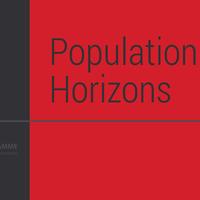Sub-Saharan Africa is not only the last region to initiate the fertility transition, it also has experienced a weaker pace of decline in fertility compared to other regions. While the global story on family size is generally very positive, with two thirds of the world’s countries now at or below replacement level, in sub-Saharan Africa women are still bearing over five children on average. This rises to over six or even seven in countries such as Chad, Mali and Niger. This rapid population growth and high fertility threaten the well-being of individuals and communities across sub-Saharan Africa. As Howse, in the first edition of the new relaunched Oxford Horizons Journal – Population Horizons, states:
“A large increase in the numbers of children puts a massive strain on countries that already struggle to provide enough schooling for their populations. Cities that are already bursting at the seams threaten to grow into increasingly unmanageable megacities, which makes it harder and harder for them to keep up with the demand for infrastructure and productive employment, and this in turn impairs their potential to act as engines of economic growth”[i].
The near 10% projected additional increase in maximum global population this century announced by the UN last year largely arises from the fact that the fertility rate in Africa has declined more slowly than expected, and indeed appears to be stalling in several countries. Furthermore even if the pace of fertility decline picks up, given the large young African population with current high levels of childbearing, the region faces many decades of rapid population growth and high child dependency. This not only has consequences for maximum world population, and the ability to feed that population, but also undermines the prospects for development and reduces the potential for an African demographic dividend.
The plight of Niger, a country with the highest fertility rates in the world, illustrates this. Some 7.5 million Nigeriens, roughly half the country, are now without adequate food. Furthermore the shrinking arable land beset by frequent drought, is supporting a rapidly expanding population. Half the population, which is expected to grow from some 16 million today to 55 million in 2050, reaching 140 million by the end of the century, is under 15. Over one quarter of girls are married by this age, rising to 60% by age 19, far higher in rural communities, where the majority are married at 12 or 13. Not surprisingly, similar proportions have given birth to children by these ages.
The UN 2012 medium population growth scenario predicts that sub-Saharan Africa’s fertility rate will fall to around three children per woman by 2050 and come down to replacement later this century. However others, such as Howse, argue that Africa has different cultural and economic dynamics and that childbearing may well remain high. In particular, as Howse demonstrates, there is clear evidence of stalling in the rate of decline in child bearing. Indeed, with the exception of the southern African countries, sub-Saharan fertility stalling seems to be far from exceptional: the average pace of fertility decline slowed significantly in Sub-Saharan African countries between the mid-1990s and the early 2000s. As many as two thirds of the countries in the region experienced no significant decline in the first decade of the millennium, 4 have yet to start fertility decline, and 10 have fertility stalls. Even in those countries where fertility is declining, the rate of decline is in most cases relatively slow.
|
Started fertility transition but now stalled |
Pre-transitional TFR over 6 |
Started transition, stalled but now declining |
|
Benin Burkina Faso Cameroon Cote d’Ivoire Gabon Guinea Mozambique Nigeria Zambia Zimbabwe |
Burundi Chad Mali Niger |
Ethiopia Ghana Kenya Madagascar Rwanda Senegal Tanzania Togo Uganda |
It is now considered likely that the marked change of pace in fertility decline across Sub-Saharan Africa may well be a regional trend. Factors may also be intervening that are specific to the Sub-Saharan case, or to the specific circumstances within which African is now in transition, which may be different from early time periods. It has been argued, for example, that despite large differences in total fertility, there are strong similarities in the patterns of family building across sub-Saharan Africa, and that the persistence of high to medium-high fertility regimes across the region can be understood in relation to the wider institutional context in which African women’s childbearing occurs. As Moultrie and Timaeus argued in their recent presentation at PAA in Boston
“Historical institutions affecting attitudes towards childbearing, combined with contemporary social, political and economic uncertainty and institutional capriciousness, have inhibited the African fertility transition. Until these institutional dynamics, and their path-dependence are engaged with, Africa’s fertility decline will remain slow”.
Fertility stalls or fertility reversals maybe a result of deliberate reproductive strategies of couples. Because couples might have an economic advantage to produce children who will be sent later in migration and who could remit money to the family, they may choose to have more children.
The position of Kenya illustrates this last point clearly. The number of children per women of child bearing age dropped dramatically in the last three decades of the 20th Century, falling from over 8 children to 5, the total fertility rate then remained at just below 5 for the next decade, although there are indications that it may be again falling. Detailed analysis of the reasons for this suggested by Westoff and Cross, for example, suggest that the main reason was a shift towards women wanting more children.
However, Moultrie et als 2012 paper in Population Studies, argues that postponement of childbearing coupled with high levels of desired fertility, is a rational response to the uncertain personal and institutional context in which the majority of African women find themselves. Despite wide variation in the TFR – from near replacement in South Africa to 7 in Niger – there was a general increase in the intervals between births, and they argued that postponement of childbearing in the region represents purposeful family strategy[ii]. In this they draw on the excellent anthropological work of Johnson-Hanks – which deserves much more attention. She points out that
Parents cannot reliably trade child quality for child quantity, or predict that the foreign models of reproduction that now appear promising will not fall apart tomorrow. Prices for schooling, healthcare, or housing are extremely unstable, as are wages; even government employees are not paid reliably in some countries. Most employment opportunities are filled through social networks or kin relations, rather than according to formal skills or job experience; few people have access to formal credit. Buses do not run on schedule. Electricity and running water go out regularly, even in capital cities. In the rainy season, roads get washed out. Insect-borne diseases like malaria seem to strike more or less at random; the water-borne and sexually transmitted ones, from cholera to HIV/AIDS, only marginally less so. Mortality rates at all ages are high, and death often unpredictable.
As Moultrie et al conclude:
Uncertainty about the future – property rights, education quality, employment prospects for one’s children, and the absence of social welfare systems in most parts of the continent – militate against rapid declines in fertility.
In other words – there is still a relatively high desired family size and women still want children for cultural and economic reasons: thus due to poverty and economic insecurity children are still required for labour, for late life security and increasingly for remittances. However poverty and economic insecurity also means that there is uncertainty about health, education, jobs, food, water – thus the best time to have the next child is unclear.
Drawing on work done with my colleague George Leeson from Oxford and Tim Searchinger’s group from the World Resource Institute, Creating a Sustainable Food Future, it is argued in this first edition of Population Horizons, that achieving replacement level fertility in Africa this century would huge benefits to African women, communities, and countries. If African women matched the replacement childbearing levels of other regions by the middle of the century, then sub-Saharan Africa’s population would stand at 1.76 billion by 2050, roughly 340 million fewer people than UN’s current growth scenario. Such a reduction would reduce global food demand by approximately 401 trillion calories per year, roughly 7% of the predicted global calorie gap in 2050, and would reduce the growth in sub-Saharan’s Africa’s food demand by roughly one third by 2050.
Understanding whether these fertility stalls in Africa are but a minor pause in the course of the fertility decline, or whether this is an indication of deeper processes, is crucial to this ambition.
About the Author
Sarah Harper is Professor of Gerontology at the University of Oxford, Director of the Oxford Institute of Population Ageing and Senior Research Fellow at Nuffield College.
[i] Howse, K. (2014) Why is fertility stalling and why does it matter? Population Horizons No.1
[ii]Postponement of childbearing sees a lengthening between births; stopping is the cessation of childbearing; spacing is where the timing of childbearing is contingent on the age of the youngest child (Moultrie, Tom A., Takudzwa S Sayi and Ian M. Timæus (2012) Birth intervals, postponement, and fertility decline in Africa: A new type of transition? Population Studies 66(3):241-258).
Opinions of the blogger is their own and not endorsed by the Institute
Comments Welcome: We welcome your comments on this or any of the Institute's blog posts. Please feel free to email comments to be posted on your behalf to administrator@ageing.ox.ac.uk or use the Disqus facility linked below.













